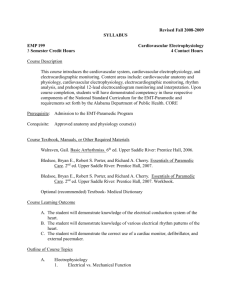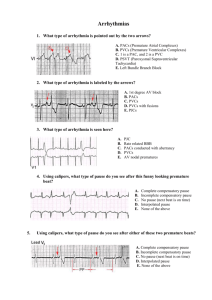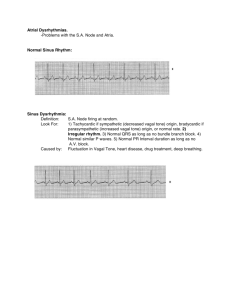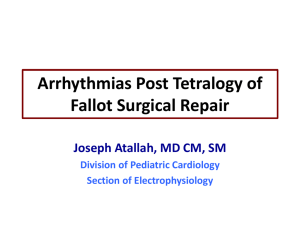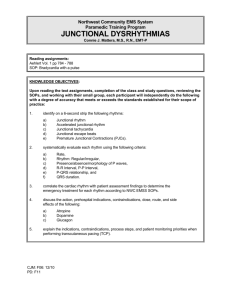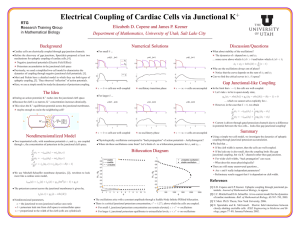Chapter13_Detailed_Answers
advertisement
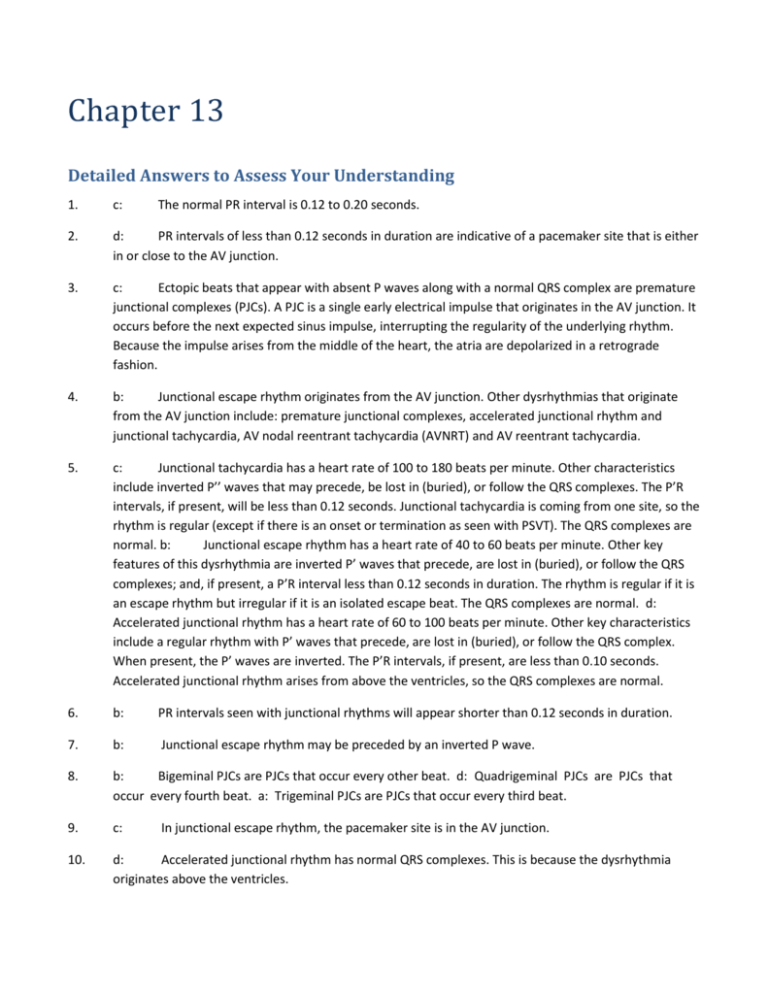
Chapter 13 Detailed Answers to Assess Your Understanding 1. c: The normal PR interval is 0.12 to 0.20 seconds. 2. d: PR intervals of less than 0.12 seconds in duration are indicative of a pacemaker site that is either in or close to the AV junction. 3. c: Ectopic beats that appear with absent P waves along with a normal QRS complex are premature junctional complexes (PJCs). A PJC is a single early electrical impulse that originates in the AV junction. It occurs before the next expected sinus impulse, interrupting the regularity of the underlying rhythm. Because the impulse arises from the middle of the heart, the atria are depolarized in a retrograde fashion. 4. b: Junctional escape rhythm originates from the AV junction. Other dysrhythmias that originate from the AV junction include: premature junctional complexes, accelerated junctional rhythm and junctional tachycardia, AV nodal reentrant tachycardia (AVNRT) and AV reentrant tachycardia. 5. c: Junctional tachycardia has a heart rate of 100 to 180 beats per minute. Other characteristics include inverted P’’ waves that may precede, be lost in (buried), or follow the QRS complexes. The P’R intervals, if present, will be less than 0.12 seconds. Junctional tachycardia is coming from one site, so the rhythm is regular (except if there is an onset or termination as seen with PSVT). The QRS complexes are normal. b: Junctional escape rhythm has a heart rate of 40 to 60 beats per minute. Other key features of this dysrhythmia are inverted P’ waves that precede, are lost in (buried), or follow the QRS complexes; and, if present, a P’R interval less than 0.12 seconds in duration. The rhythm is regular if it is an escape rhythm but irregular if it is an isolated escape beat. The QRS complexes are normal. d: Accelerated junctional rhythm has a heart rate of 60 to 100 beats per minute. Other key characteristics include a regular rhythm with P’ waves that precede, are lost in (buried), or follow the QRS complex. When present, the P’ waves are inverted. The P’R intervals, if present, are less than 0.10 seconds. Accelerated junctional rhythm arises from above the ventricles, so the QRS complexes are normal. 6. b: PR intervals seen with junctional rhythms will appear shorter than 0.12 seconds in duration. 7. b: Junctional escape rhythm may be preceded by an inverted P wave. 8. b: Bigeminal PJCs are PJCs that occur every other beat. d: Quadrigeminal PJCs are PJCs that occur every fourth beat. a: Trigeminal PJCs are PJCs that occur every third beat. 9. c: 10. d: Accelerated junctional rhythm has normal QRS complexes. This is because the dysrhythmia originates above the ventricles. In junctional escape rhythm, the pacemaker site is in the AV junction. 11. d: With preexcitement syndromes impulses are conducted through accessory conduction pathways between the atria and ventricles. 12. In WPW impulses bypass the AV node by traveling from the atria to the ventricles via the bundle of Kent. In WPW, the QRS complexes are widened with slurring or upslope of the initial portion (delta wave) due to a small area of the ventricle being depolarized early via the bundle of Kent. Be sure to scan the entire ECG as a true delta wave may be seen in only a few leads. 13. c: Paroxysmal means abruptly, without warning. Because the rhythm originates above the ventricle it is called supraventricular and because it is greater than 100 it is tachycardic. 14. b: Because the rate is so fast the P waves occur shortly after the QRS complex and are imbedded in the T wave. 15. a: PSVT occurs when an impulse originating in the atria stimulates the AV node to fire and then follows accessory pathways back to the point of origin reinitiating the impulse. This is called a “circus” impulse because it circles the atria in a self-perpetuating manner.
